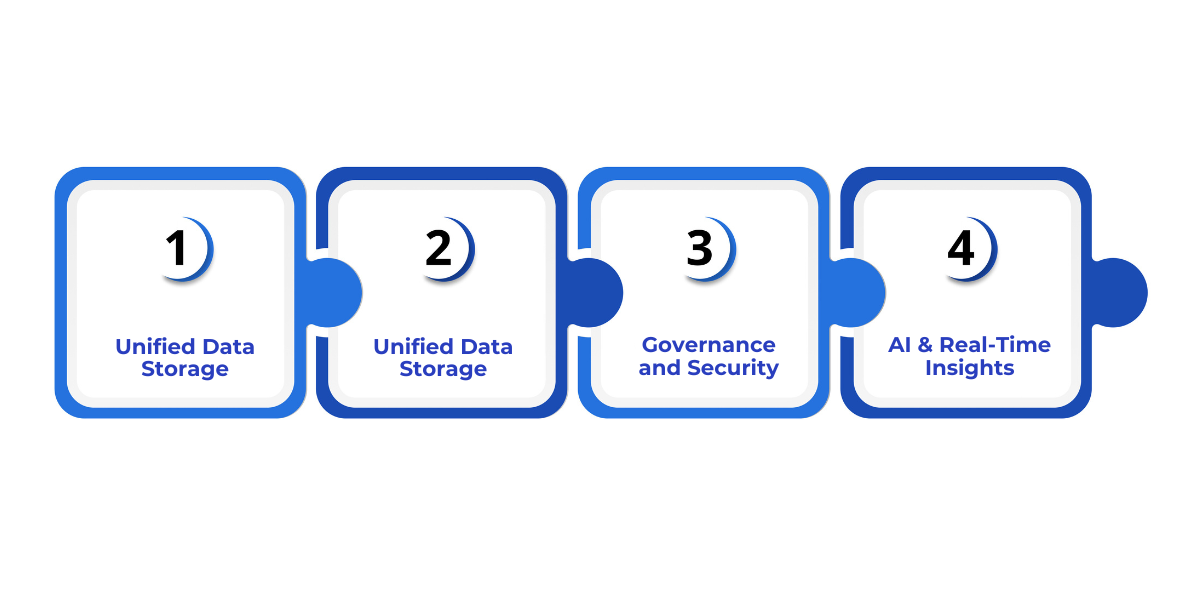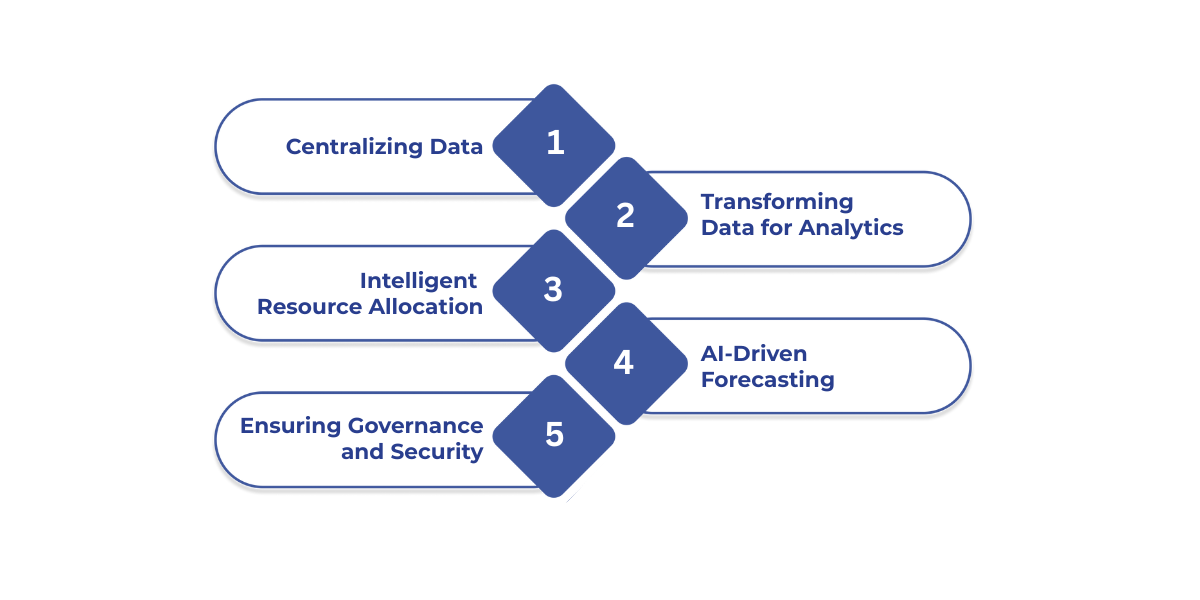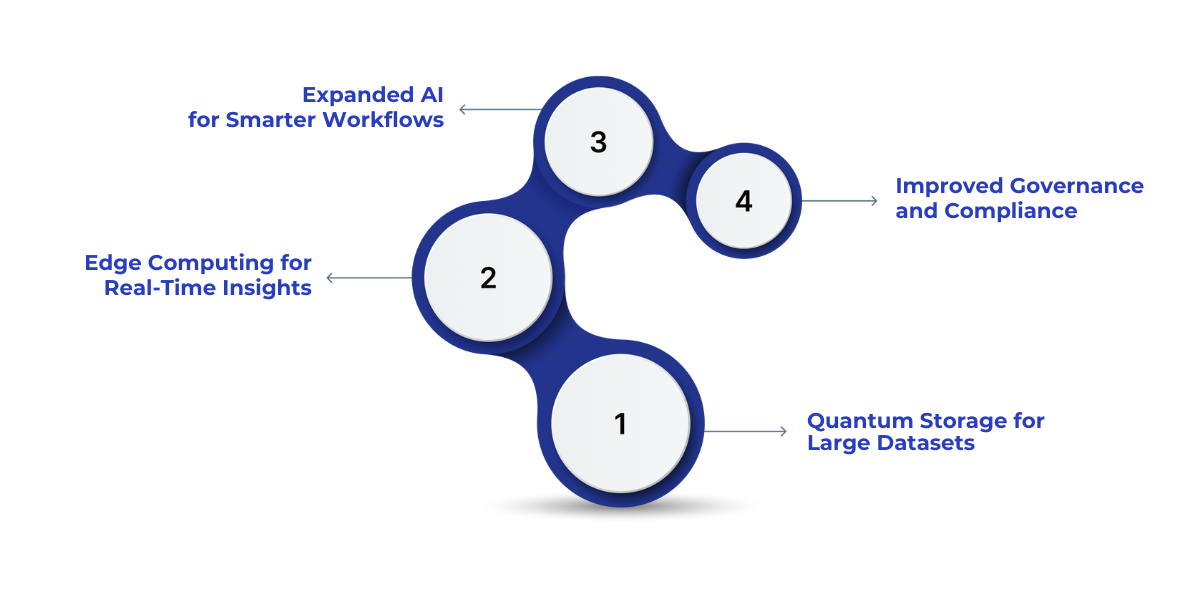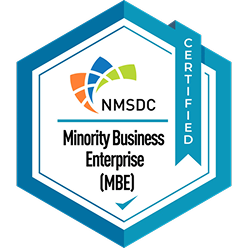

An Azure architecture diagram, Microsoft Fabric, illustrates how this modern, cloud-based platform unites lakehouse and warehouse features, real-time analytics, and AI. With Fabric, enterprises can centralize data operations, accelerate insights, enhance decision-making, and maintain governance across complex analytics workloads.
This guide walks you through Microsoft Fabric end-to-end insights. It covers the architecture, core components, integration patterns, security, governance, implementation steps, and migration scenarios, with a strong focus on enterprise use cases.
Before looking at the technical details, let’s see why Microsoft Fabric architecture matters for enterprises.
An effective Microsoft Fabric strategy integrates people, processes, and technology to maximize the value of enterprise data. An Azure architecture diagram Microsoft Fabric provides a visual overview of how data flows, storage consolidates, and analytics and AI components interact across the platform.
It involves creating a framework for collecting, storing, managing, and analyzing data in a secure, scalable, and accessible manner. This approach allows teams to act on insights faster and make more informed decisions across business functions.
Next, let’s examine how enterprises migrate existing workloads to Fabric smoothly.
Moving to Microsoft Fabric requires careful planning and the right set of tools to maintain efficiency and minimize disruption. An Azure architecture diagram Microsoft Fabric can help teams visualize migration steps and Integration of Modern platforms like Microsoft Fabric points.
To start the migration process smoothly, businesses can use specialized methods tailored for their existing systems.
These migration approaches not only simplify the transition but also ensure that existing data pipelines integrate seamlessly into the Fabric ecosystem.
Once migrated, Microsoft Fabric offers several capabilities that transform how organizations manage and utilize data. These features work together to provide a unified, efficient, and actionable data environment.
Key features include:

Now, let’s explore the core capabilities that make Fabric a unified and actionable platform.

Before exploring individual components, it’s helpful to visualize how they work together. An Azure architecture diagram Microsoft Fabric provides a clear view of how these components integrate for end-to-end data management.
Microsoft Fabric unites storage, processing, analytics, and AI in a single platform. Understanding each component helps enterprises streamline data operations and accelerate insights.
Here’s how each component contributes to the end-to-end analytics workflow:
As shown in the Azure architecture diagram Microsoft Fabric, OneLake acts as the central hub connecting all analytics and AI processes. It consolidates structured and unstructured data, eliminates silos, and simplifies access across the organization.
Key Capabilities:
By centralizing data in OneLake, organizations can accelerate downstream analytics, improve governance, and reduce operational complexity.
Once data is stored, it needs to be transformed and prepared for analytics. The diagram also shows how Synapse Data Engineering transforms raw data into structured, analytics-ready datasets. It enables scalable pipelines and collaborative workspaces for efficient data processing.
Capabilities:
This component ensures that raw data becomes structured, clean, and ready for analytics without moving it between multiple tools.
Also Read: Microsoft Synapse vs Fabric: Comprehensive Comparison
For structured datasets, Synapse Data Warehouse delivers enterprise-grade analytics. It enables organizations to query, analyze, and model large volumes of data quickly.
The diagram highlights its connection to OneLake and other components, ensuring high-performance analytics.
Key Features:
Synapse Data Warehouse allows decision-makers to extract insights efficiently while maintaining high performance and scalability.
Many enterprises need to analyze data as it arrives. Real-time analytics capabilities are visualized in the architecture diagram, showing how live data from IoT devices, logs, and events is processed immediately for actionable insights.
Capabilities:
Real-time analytics ensures organizations respond quickly to changing conditions and opportunities.
Also Read: Batch vs Real-Time Data Processing: Integration and Design Differences
Data Factory automates ETL/ELT pipelines, linking all Fabric components. The diagram helps teams see the flow of data from ingestion to analytics and reporting.
Capabilities:
With Data Factory, businesses can reduce manual intervention and ensure data flows seamlessly from ingestion to analytics.
Finally, Power BI transforms processed data into dashboards and reports. The architecture diagram illustrates its integration with OneLake and Synapse, enabling real-time insights and faster decision-making.
Key Features:
Power BI empowers decision-makers to act on insights quickly, improving business outcomes and operational efficiency.
With these components in place, enterprises can use Fabric to drive real-world business insights, such as improving retail operations.

Microsoft Fabric provides a unified platform that connects data architecture, storage, processing, and visualization, enabling enterprises to act on insights faster and make smarter business decisions. For a retail enterprise aiming to improve sales forecasting and inventory management, Fabric streamlines every step of the process.
Before you can extract insights, all relevant data must be collected and organized in one place. This foundation ensures that analytics teams work with a consistent and complete dataset.
Here’s how Fabric centralizes your data:
Raw data must be prepared before it can provide value. Transformation cleans, organizes, and enriches the data to make it ready for analysis.
Key ways Fabric handles data transformation:
Once data is ready, visualization tools make it easy to understand and act on. Fabric ensures that insights are accessible and actionable.
Here’s how analytics and reporting work:
Predictive intelligence adds another layer of value, helping businesses plan ahead rather than just react.
Fabric applies AI and machine learning in these ways:
Protecting your data is essential for trust, compliance, and accuracy. Fabric builds governance into every step of the workflow.
Governance and data security are managed through:
Also Read: Integrating Microsoft Fabric for Scalable Healthcare Data Solutions
Next, let’s explore into how Fabric connects and integrates data across systems.

To get the most from Microsoft Fabric, it’s important to understand how data moves and connects across the platform. Integration patterns ensure secure, efficient, and high-performance workflows that unify data from multiple sources.
Understanding integration is easier with an Azure architecture diagram Microsoft Fabric, which illustrates connections between external systems, Fabric components, and real-time analytics workflow
Here’s how Microsoft Fabric connects and integrates data across systems:
Within Fabric, data flows automatically between services. Shared metadata maintains consistency across components, while role-based security and context propagation protect sensitive information.
Intelligent caching and workflow optimizations improve processing speed and resource efficiency, enabling real-time analytics and faster insights even for large datasets.
While AI integration supports smooth operations, deploying Fabric at scale comes with challenges that must be addressed.
Implementing Microsoft Fabric architecture brings powerful analytics and AI capabilities to enterprises, but it also comes with challenges that can affect performance, reliability, and scalability.
Understanding these challenges and applying proven solutions ensures a smooth deployment and maximizes the platform’s value.
Here are some major key challenges and solutions:
A poorly planned architecture can lead to downtime, data loss, or inefficient resource use. To overcome these challenges, enterprises should follow structured design principles.
Solutions:
Managing development within Fabric requires coordination across teams, automated testing, and reliable deployment pipelines. Common challenges include errors in deployments and inconsistent data pipelines.
Solutions:
Without proper optimization, Fabric workloads may experience slow queries, high costs, or inefficient resource usage.
Solutions:
Enterprises can plan migrations by consulting an Azure architecture diagram Microsoft Fabric to map current workloads to the Fabric ecosystem.
Also Read: Thinking of Working with a Microsoft Fabric Partner? Here’s What to Expect
Looking ahead, it’s important to see how Microsoft Fabric continues to adapt to growing data demands and emerging technologies.

Future-ready updates, such as edge computing or quantum storage, can also be visualized in an Azure architecture diagram Microsoft Fabric to see how new features fit into the existing architecture
Key trends shaping the future of Fabric include:
With these innovations, Microsoft Fabric helps enterprises build a more connected analytics ecosystem, make quicker decisions, and create a future-ready data infrastructure that turns raw data into valuable insights.
Microsoft Fabric Architecture offers enterprises a unified and scalable platform to modernize analytics. From ingestion and transformation to modeling and real-time reporting, it enables faster insights, simplified operations, and AI-driven decision-making.
As organizations continue to handle complex and growing data environments, Fabric will remain a key solution for reducing operational complexity, ensuring compliance, and driving intelligent outcomes.
At WaferWire, we help businesses design, implement, and optimize Microsoft Fabric solutions tailored to their needs.
Contact us today to start your journey toward secure, future-ready enterprise analytics.
1. What is Microsoft Fabric Architecture, and why is it important?
Microsoft Fabric Architecture provides an integrated platform that combines lakehouses, warehouses, real-time analytics, and AI capabilities. It helps organizations unify data operations, reduce silos, and deliver faster insights.
2. How does Microsoft Fabric differ from traditional data warehouses and lakehouses?
Unlike traditional systems, Microsoft Fabric brings together OneLake storage, Delta format transformation, real-time analytics, and Power BI integration. This unified approach simplifies data management and enables end-to-end analytics in a single ecosystem.
3. Can Microsoft Fabric Architecture handle both real-time and batch data?
Yes. Fabric supports real-time ingestion through Event Streams as well as batch ingestion using pipelines and dataflows. This flexibility ensures businesses can process IoT data, APIs, and databases efficiently.
4. How does Microsoft Fabric Architecture support scalability for enterprises?
Fabric’s cloud-native design on Microsoft Azure enables seamless scalability. Organizations can expand storage and analytics capacity without performance trade-offs, ensuring readiness for growing data volumes.
5. What security measures are built into Microsoft Fabric Architecture?
Fabric ensures security through role-based access, metadata management, and compliance tools. Features like encryption, governance policies, and monitoring safeguard sensitive business data across the ecosystem.

